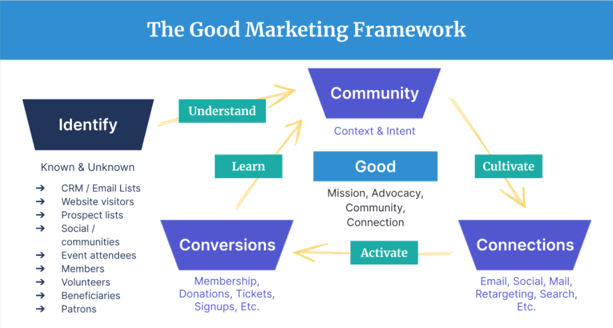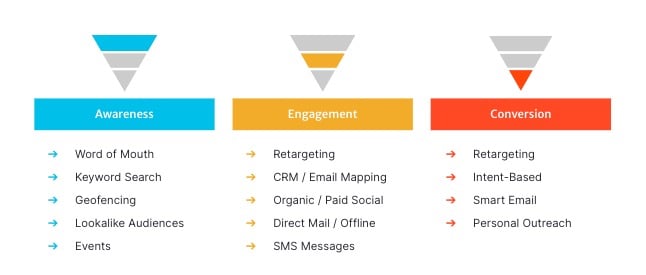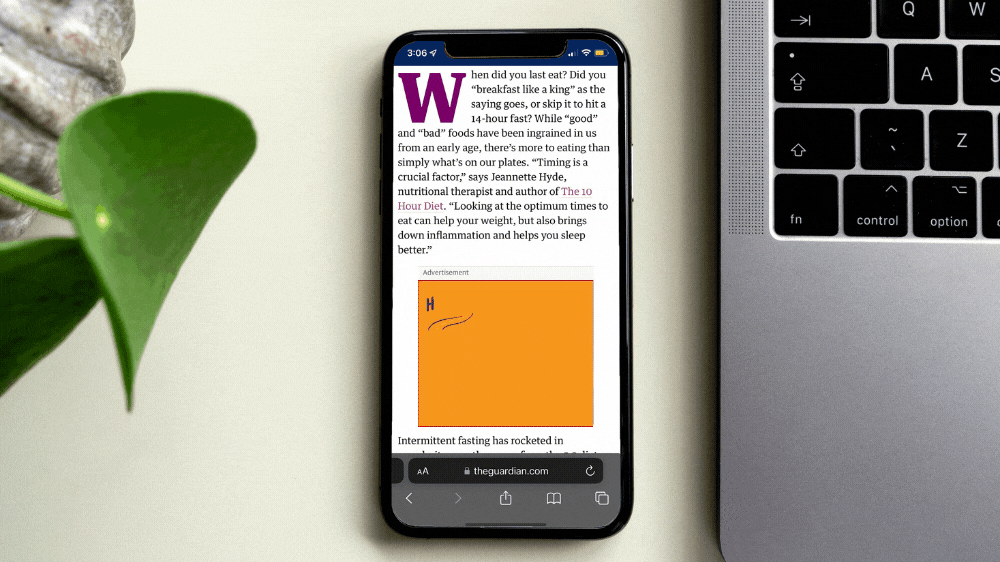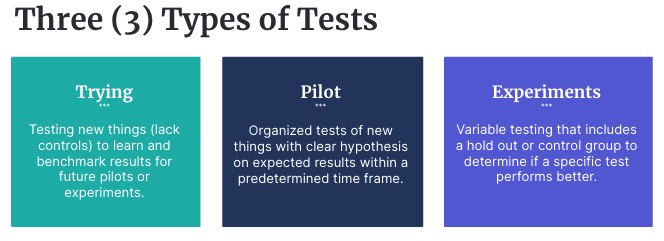
How to Grow Your Organization with The Good Marketing Framework
Change is the only constant. The ways that donors, members, volunteers, and supporters are engaging with nonprofits have recently gone through seismic changes. A few startling facts from the last two decades:
- In 2000, 66% of US households gave philanthropically. In 2022, that number is now below 50% — an over 16% decline in 22 years (GiveUSA).
- Nonprofits are perceived as less trustworthy than their corporate counterparts (2022 Edelman Trust Barometer).
It isn’t a surprise that these same years have seen the tech giants boom; Facebook, Google, Amazon, and Apple all saw accelerated growth during this period of waning philanthropic activity.
Much of the success of these platforms has been through owning and capitalizing on attention. In fact, attention has become the most valuable currency in today’s economy. And the Edelman Trust Barometer only proves that Big Tech has outpaced nonprofits in capitalizing on that most limited and precious of commodities: attention.
But how are nonprofits to respond to the simultaneous crises of decreasing financial support and trust?
Through their market dominance, tech giants have compiled the most accurate and actionable data on their audiences. And no longer are they giving this information away for free. Simply reaching current followers on LinkedIn or Instagram now requires a fee, which they call “boosting.”
And none of this even begins addressing the real elephant in the room: In 2022, Amazon employed 1,541,000 people, and this was down over 60,000 from 2021. And they earmarked $32.6 billion for marketing in 2021.
There isn’t a single nonprofit that can compete at that level. But here’s the good news; nonprofits have a couple things that a tech giant could only dream of:
- Mission: Google says that its purpose is, “to organize the world's information and make it universally accessible and useful.” But the problem is that this mission often lands on the back burner. As a transactional business, their bottom line is still the bottom line. In stark contrast, nonprofits are truly built on a cause, and every other objective is subservient to it. That’s a whole lot more compelling.
- Community: Consumers may want a new pair of Nike’s or to drive a Tesla, but people are always going to have larger aspirational identities. No amount of marketing (not even $32.6 billion!) is going to truly convince anyone that they’re defined by what they own. Nonprofits have far more meaningful information about their communities because they deal with people at their core. Corporations are optimizing for transactions where nonprofits optimize for transformation. Nonprofits are relating to people as they truly are or want to be, which gives them real power.
But many nonprofits haven’t been leveraging these assets. Instead, because of constant change, they’ve been intimidated to step into the field, especially when their competitors are labeled “giants.”
They’ve settled for ok marketing and left the lion’s share for those with bigger budgets and larger staff. But it’s time for nonprofits to lean into Good marketing, which means doing effective and efficient marketing with a bigger purpose in mind. Transactional businesses have recently been doing better marketing than nonprofits, but Good will always be just out of reach for them.
What is ok marketing? And why are nonprofits doing it?
Ok marketing is three parts magic and one part marketing. And it tends to look like one of these three strategies:
- Nothing: The age old axiom, “If you build it, they will come,” defines this strategy. But nonprofits also need to build an effective strategy for reaching their community. In a digital world, just doing what you’re doing and hoping the message gets out isn’t going to take a nonprofit as far as it should go. At the heart of this strategy is the idea that a good story tells itself, but that’s only so true, and leaves the marketing in an ok place. Nonprofits should be ecstatic about sharing their stories. They should shout it from the rooftops so that more people can join in. And that’s where Good marketing comes in.
- Everything: The flip side of the nothing coin is everything. Instead of saying that the story will get out on its own, this is where the nonprofit tries every single trick in the book. But the problem is that most nonprofits don’t have 1.5 million employees, so a lot of these campaigns are going to add nothing. This is a case where trying to do everything means that they’re effectively doing nothing.
- One offs: The nonprofit sees a shiny new channel or tactic and throws together a budget. They run full steam ahead on that platform — often performing the best practices. But without an overarching marketing strategy, results are limited and data is hard to pull into a cohesive narrative. Because the whole strategy was built around a channel or tactic, the audience was an afterthought. Even if the campaign had some positive impact, it may not have effectively pushed the needle for the people they were really wanting to activate.
Looking at recent trends and working with limited time and budgets, it’s hard not to feel overwhelmed. And even if a nonprofit is in one of these buckets, who has the time or resources to climb out of that hole?
This is where The Good Marketing Framework comes in. A framework is a shortcut to solving a complex challenge. Each nonprofit faces its own set of complex and unique challenges — ones that require time, budget, and planning.
And The Good Framework was developed in partnership with over a thousand nonprofits. It’s built with their complex challenges in mind and meant to spark the conversations nonprofit teams need to have to more effectively reach and impact their communities.
Good marketing is at the center of the nonprofit sector’s future growth, and when nonprofits grow, the world becomes just a little bit better. With the aid of a framework, nonprofits won’t only find their footing in these uncertain times but they’ll even begin to soar.
So, what is The Good Marketing Framework?
Instead of a plan that relies on magic, The Good Marketing Framework is defined by these four guiding principles:
- Audience first: Understanding an audience and community is the first step in deciding where to allocate time and energy. Only then can teams decide where to effectively engage with their community. If audiences aren’t on TikTok, no amount of investment on the platform will produce meaningful results.
- Responsive: Responsive isn’t reactive — it’s instead forward thinking. Gone are the days of simply personalizing an email with the recipient’s first name. Responsive strategies listen to people’s actions and respond accordingly. Say a potential donor lands on a donation page but fails to give in the moment. Responsive marketing could follow up with an email describing the positive impact a recurring monthly gift can make. Or another responsive play could be to send advertisements to make sure they don’t forget to complete the donation.
- Omnichannel: This is the flip side of one-off campaigns. Instead of running a single campaign and calling it a day, Good marketers orchestrate a symphony through the channels it uses. By starting with the audience in mind, the most effective organizations are centering their strategies around their community and telling one story through multiple platforms. Today, an email can be followed up with an ad or a text message, reinforcing the same message. And the whole ends up becoming much more than the parts were alone.
- Measurable: The tech giants have dominated in the field of data collection and analytics. But nonprofits have valuable information about their communities at their fingertips, and they often aren’t tapping this valuable resource. Peter Drucker, the father of modern management, said, “What gets measured, gets managed.” Repeatable results don’t happen accidentally or overnight. It takes collecting reliable data and making informed decisions off of that data to create repeatable and consistent growth.
Nonprofits face real pressures from within and without. They’re often given impossible tasks with small budgets and teams. And the work really matters, which makes it so much harder when the numbers aren’t moving in the right direction.
Good marketing can turn this story around for nonprofits — that’s marketing that’s audience-first, responsive, measurable, and is all built with the best of intentions: making the world a better place for us all.
The Good Marketing Framework
Let’s start with the end first, and then we’ll unpack each of these elements in more detail.

There are four phases in the Framework: Understand, Cultivate, Activate, and Learn. Identifying a target audience is the prerequisite that allows nonprofit marketers to step into The Good Marketing Framework.
Once the audience is identified, understanding the context and intent of that community is step one. Cultivating that community drives engagement and sparks dialogue. Then, activating that engaged community creates impact.
But that’s not it. The work of Good marketing is never finished because more people need to hear about the incredible work of nonprofits. Now that the campaigns have wrapped, it’s time to pull all the data together, find patterns, and apply those into the coming year. This step is key for nonprofits that want to build their impact.
This framework can be applied across the entire donor, member, or volunteer journey. So it isn’t simply a linear process. And because of this, it doesn’t replace the donor funnel or journey or lifecycle. But rather this framework applies to each stage along the way based on the community.
Let’s dive into each step in more detail:
Step 0 - Identify
This is the prerequisite before the Good work of marketing can begin. Marketing doesn’t happen in a vacuum — it happens in a market. There’s no Good marketing until the market is defined. Organizations need to know who they’re for before they can create meaningful engagement with those people.
Oftentimes, this step feels like it’s answered by the nature of the organization. But it’s always worth the additional time to dive deeper into identifying who it is in that audience that’s worth added investment and engagement with.
Maybe an organization has a large group of donors in their 50s and 60s, but they want to increase awareness for younger generations. Or maybe they feel like they haven’t engaged effectively with their major donors. Only by identifying an audience can they take the active steps of understanding, cultivating, and activating them.
Step 1 - Understand
Instead of running a LinkedIn or TikTok campaign right off the bat, it’s essential to first understand who the audience is and who it isn’t. If they’re on LinkedIn, then a LinkedIn campaign makes a lot of sense. But if they aren’t, that’s going to be a lot of time and money down the drain.
What’s known about a community is going to drive the most successful marketing campaigns. And the first two things that need to be understood are a community’s context and intent.
So, what are context and intent?
Context: This is what’s known about the audience and what the audience knows about the nonprofit. Are they long-time supporters? Have they attended a recent event? Or did they stumble onto the website for the first time last week? Context ultimately boils down to what a community’s relationship is to the organization.
Understanding context also gives insight into the stage an audience is along the donor or member journey or funnel. Essentially audiences fall into one of three major categories: They’re unaware of an organization and the core objective is to bring them to awareness. They are aware of the organization, but the organization wants to re-engage or engage more deeply with them. Or they’re already engaged, and it’s time for activation or conversion. This is further context.

Intent: Answering intent is about understanding what an audience intends to do. This is all about understanding motivations and behaviors. If a past donor navigated to a donation page, but failed to make a donation, it can be assumed that this was their intent. The same is true if they visited a registration page for an upcoming event or if someone began to fill out a volunteer sign-up form. Intention is ultimately about looking for signals of future action.
It can be disappointing for a nonprofit to see someone with 0 context and 0 intent. But knowing is the first step. Only with accurate information about context and intent can Good marketers properly take the next step in bringing awareness, increasing engagement, or activating a community member.
Once context and intent are surfaced, nonprofits should begin to create segments or groups that share essential qualities. Interacting with a donor will naturally look different than engaging with a volunteer. So placing people in the right segments is the right next step in developing Good marketing campaigns.
Some possible segments that could be unearthed during the understanding phase: active supporters, current members, lapsed members, beneficiaries, website visitors, event attendees, volunteers, patrons.
Real-world example:
Think about segmentation from a museum’s perspective. Visitors come in on a daily basis, but unless they have a meaningful way of following up with these patrons, they’re just there and gone. Finding a way to collect contact information so that they can follow up with these visitors in the future is an excellent first step in the understanding process for a museum. Knowing who’s walking through the doors is a humongous value for a museum’s future marketing efforts.
Step 2 - Cultivate
Cultivation is all about the content and the channels an organization uses to reach and engage with their identified community. And it’s all based on their context and intent. To risk being repetitive — it’s essential that choosing the content focus and channels for distribution follow identifying and understanding an audience — who is meant to be reached, engaged, and activated.
It wouldn’t be a good use of advertising spend to send display ads explaining the basics about the mission to long-time supporters. They already know about the mission, so that’s just wasting their time.
During cultivation, relevancy is always more valuable than reach. Getting in front of 10,000 people who aren’t interested in the content is an expensive waste. But getting in front of 100 people who are highly engaged with the content could change a nonprofit tomorrow, and it likely costs a lot less too!
It’s certainly true for marketing that if someone builds their message for everyone, it’s going to be valuable for no one.
During a recent Flight School, Noah Barnett, the VP of marketing here at Feathr, said, “Big numbers aren’t results. Results are results.” Instead of going after vanity measurements like reach, Good marketers pursue things that push the needle for the organization through offering value to their community.
So, what’s a Good channel?
This is a trick question. Channels are almost limitless. Today, organizations can send text messages — they can organize online or in-person events. They can serve display ads or send direct mail. They can be active on TikTok or Facebook or Instagram or LinkedIn. And the options are always expanding.
But as we said before, the essential thing here is to choose the channels that connect with an identified audience. The Good channel is the one where the nonprofit’s community is. Optimizing a channel only brings results if the community is there. Finding out where the community is answers the question of what channel and what content they want.
Real-world examples:
An organization may want entirely new donors, but they don’t know where to start. They want to reach an audience that is already interested in their mission and work. One way to reach this group specifically is to launch a search keyword campaign that targets people who may not know about the particular organization, but have expressed interest by searching for terms around the mission or problems they address.
Hope & A Future targeted ads to a local audience explaining how Arizona gave tax credits to donors. Because this audience was entirely new to their work, they spent more time explaining the value of their mission as well as offering an incentive to give. They knew who they wanted to reach and they developed content and visuals to attract that specific audience. And because they started with the audience in mind — people in their local community that didn’t already know their work — they knocked the campaign out of the park.

Step 3 - Activate
Activate is not the same as convert. Conversion assumes that an organization is in charge and manipulating their audience. But in reality, the relationships nonprofits have with supporters and donors should be much more than transactional. And that’s why it’s important to think of this step as activation. It engages with the potential and desires of a community instead of framing it as simply getting the right behavior to take place.
Donors want to give to organizations that are making the world a better place because they want to be a part of making the world a better place. This doesn’t require a conversion. It only requires someone connecting meaningfully with the mission and knowing how they can best participate in making that vision a reality. It’s about a partnership — one where both sides benefit.
During the activation stage, it’s important to create measurable goals. One important thing to remember is that not every single one of these goals needs to be associated with a financial goal.
Yes, marketing can and should have a large impact on an organization’s revenue. But it also should build awareness, educate, and foster engagement. These things don’t always have a direct financial result, and that’s ok if they’re placed in the right context, and if ultimately they do build to make a financial impact for the organization in the long run. Rome wasn’t built overnight.
Most salesmen don’t start by trying to close the deal. The principle of getting a foot in the door is essential to understanding the marketing process. The most effective marketers encourage people to take one step with them at a time.
Getting someone to the website is a big step. Then it might be reading an email and clicking through to watch a video. Afterwards, it could be an invite to an upcoming event. Relationships take time, and supporters, members, volunteers, and donors deserve the time and attention that any relationship deserves.
Some questions to ask: What are the first yeses needed? How can those yeses be measured? How can they be built on?
Marketing doesn’t have a silver bullet. Should the email push them to donate? Should it be $50 or $10,000? Should it ask them to join a webinar first? It depends. Every audience is different, so listening closely to what works for each specific group will lead to the greatest results.
Testing, testing, testing
Let's take a slight detour and talk about different ways that nonprofits can best engage with their audiences. The best benchmark is the benchmark a nonprofit sets themselves. And the best data isn’t bought.
Instead of following someone else’s best practice, nonprofits need to see what's true for their audience. In the immortal words of The Magic School Bus’s Miss Frizzle, “Take chances, make mistakes, and get messy!”
Brady Josephson, the VP of marketing at charity: water, recently joined the Feathr crew during a Nonprofit Marketing Unplugged podcast, and he breaks up his testing at charity: water into three different buckets: tests, pilots, and experiments. The important this is for a nonprofit to have a system that allows them to learn from the different tests they make. A test is only valuable if it can be learned from.

Step 4 - Learn
What did we learn last time we reached out to this audience? What activation worked best? How do we apply what worked and didn’t work last time into the next cycle?
As high performers, we really want to know the right answer. But, the marketing world is constantly changing, and people don’t always fit into boxes. Something that worked yesterday might not work tomorrow, and something that didn’t work yesterday may just be the best way forward today. I know this is frustrating, but it’s led our team to a humility about learning and pushing forward.
The quickest way to learn is to assume I’m wrong. Then it’s time find out how wrong as quickly as possible and change direction. To learn is to fail, and this is why it’s so true to “fail fast.” Nonprofits aren’t going to win if they only play defense.
Marketing teams all over are being asked to do more with less. The Good Marketing Framework can help guide these teams into answering what’s most effective and how they can reinforce and build on those gains.
The center can hold
At the center of the marketing framework we’ve shared is the idea that marketing is Good. Marketing isn’t a sideshow to a nonprofit’s programs. It isn’t a dead end. It’s the constant and fulfilling work of sharing the work with others and inviting them into it. This is Good.
At the heart of this belief is that a community is the real driver of growth. If an organization is a car, the gas in the tank is the community. Filling up the tank would be all the actions nonprofits do to serve these people and build their trust. And that’s what Good marketing is all about.
As people, we want to think that we’re at the center of the universe. But in Good marketing, the shift is toward serving the community. And this service can build a nonprofit into a movement.
This is marketing. And it’s Good stuff.
Fly with us
If you’re looking for a Good Marketing Partner to help build out your organization’s marketing strategy, Feathr has worked with over 1,000 nonprofits to successfully expand awareness and boost revenue.
From teachers associations to humane societies, Feathr has helped nonprofits of all wingspans soar, making the world just a little better in the process.
Through those partnerships, we created The Good Marketing Framework to help you and your team apply the same principles to your marketing efforts.
And with Feathr’s software solutions, your team will unlock insights about your community, giving you clear and actionable data so that your team can continue to expand its impact.
We have a team of flight instructors waiting on the tarmac, ready to train, coach, and help you apply The Good Marketing Framework to whatever context you face.
We want to see your nonprofit take off, and we believe our strategies, software solutions, and support can get you off the ground and soaring!
You May Also Like
These Related Stories

The cost of inaction: Strategies for nonprofits facing the funding freeze

How to Design a Responsive Nonprofit Marketing Plan

